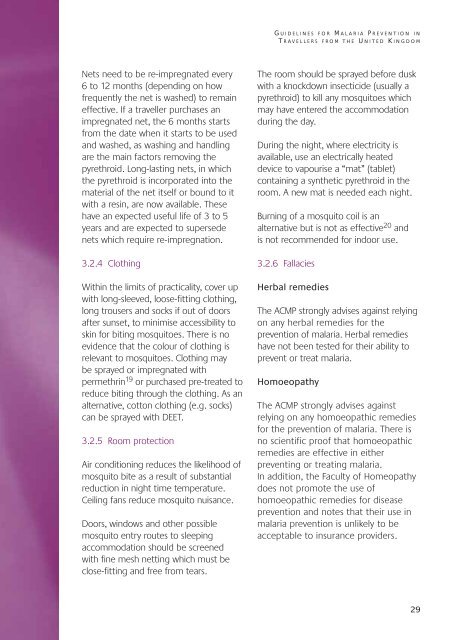Guidelines for malaria prevention in travellers from the United ...
Guidelines for malaria prevention in travellers from the United ...
Guidelines for malaria prevention in travellers from the United ...
Create successful ePaper yourself
Turn your PDF publications into a flip-book with our unique Google optimized e-Paper software.
Nets need to be re-impregnated every<br />
6 to 12 months (depend<strong>in</strong>g on how<br />
frequently <strong>the</strong> net is washed) to rema<strong>in</strong><br />
effective. If a traveller purchases an<br />
impregnated net, <strong>the</strong> 6 months starts<br />
<strong>from</strong> <strong>the</strong> date when it starts to be used<br />
and washed, as wash<strong>in</strong>g and handl<strong>in</strong>g<br />
are <strong>the</strong> ma<strong>in</strong> factors remov<strong>in</strong>g <strong>the</strong><br />
pyrethroid. Long-last<strong>in</strong>g nets, <strong>in</strong> which<br />
<strong>the</strong> pyrethroid is <strong>in</strong>corporated <strong>in</strong>to <strong>the</strong><br />
material of <strong>the</strong> net itself or bound to it<br />
with a res<strong>in</strong>, are now available. These<br />
have an expected useful life of 3 to 5<br />
years and are expected to supersede<br />
nets which require re-impregnation.<br />
3.2.4 Cloth<strong>in</strong>g<br />
With<strong>in</strong> <strong>the</strong> limits of practicality, cover up<br />
with long-sleeved, loose-fitt<strong>in</strong>g cloth<strong>in</strong>g,<br />
long trousers and socks if out of doors<br />
after sunset, to m<strong>in</strong>imise accessibility to<br />
sk<strong>in</strong> <strong>for</strong> bit<strong>in</strong>g mosquitoes. There is no<br />
evidence that <strong>the</strong> colour of cloth<strong>in</strong>g is<br />
relevant to mosquitoes. Cloth<strong>in</strong>g may<br />
be sprayed or impregnated with<br />
permethr<strong>in</strong> 19 or purchased pre-treated to<br />
reduce bit<strong>in</strong>g through <strong>the</strong> cloth<strong>in</strong>g. As an<br />
alternative, cotton cloth<strong>in</strong>g (e.g. socks)<br />
can be sprayed with DEET.<br />
3.2.5 Room protection<br />
Air condition<strong>in</strong>g reduces <strong>the</strong> likelihood of<br />
mosquito bite as a result of substantial<br />
reduction <strong>in</strong> night time temperature.<br />
Ceil<strong>in</strong>g fans reduce mosquito nuisance.<br />
Doors, w<strong>in</strong>dows and o<strong>the</strong>r possible<br />
mosquito entry routes to sleep<strong>in</strong>g<br />
accommodation should be screened<br />
with f<strong>in</strong>e mesh nett<strong>in</strong>g which must be<br />
close-fitt<strong>in</strong>g and free <strong>from</strong> tears.<br />
G UIDELINES FOR M ALARIA P REVENTION IN<br />
T RAVELLERS FROM THE U NITED K INGDOM<br />
The room should be sprayed be<strong>for</strong>e dusk<br />
with a knockdown <strong>in</strong>secticide (usually a<br />
pyrethroid) to kill any mosquitoes which<br />
may have entered <strong>the</strong> accommodation<br />
dur<strong>in</strong>g <strong>the</strong> day.<br />
Dur<strong>in</strong>g <strong>the</strong> night, where electricity is<br />
available, use an electrically heated<br />
device to vapourise a “mat” (tablet)<br />
conta<strong>in</strong><strong>in</strong>g a syn<strong>the</strong>tic pyrethroid <strong>in</strong> <strong>the</strong><br />
room. A new mat is needed each night.<br />
Burn<strong>in</strong>g of a mosquito coil is an<br />
alternative but is not as effective 20 and<br />
is not recommended <strong>for</strong> <strong>in</strong>door use.<br />
3.2.6 Fallacies<br />
Herbal remedies<br />
The ACMP strongly advises aga<strong>in</strong>st rely<strong>in</strong>g<br />
on any herbal remedies <strong>for</strong> <strong>the</strong><br />
<strong>prevention</strong> of <strong>malaria</strong>. Herbal remedies<br />
have not been tested <strong>for</strong> <strong>the</strong>ir ability to<br />
prevent or treat <strong>malaria</strong>.<br />
Homoeopathy<br />
The ACMP strongly advises aga<strong>in</strong>st<br />
rely<strong>in</strong>g on any homoeopathic remedies<br />
<strong>for</strong> <strong>the</strong> <strong>prevention</strong> of <strong>malaria</strong>. There is<br />
no scientific proof that homoeopathic<br />
remedies are effective <strong>in</strong> ei<strong>the</strong>r<br />
prevent<strong>in</strong>g or treat<strong>in</strong>g <strong>malaria</strong>.<br />
In addition, <strong>the</strong> Faculty of Homeopathy<br />
does not promote <strong>the</strong> use of<br />
homoeopathic remedies <strong>for</strong> disease<br />
<strong>prevention</strong> and notes that <strong>the</strong>ir use <strong>in</strong><br />
<strong>malaria</strong> <strong>prevention</strong> is unlikely to be<br />
acceptable to <strong>in</strong>surance providers.<br />
29


